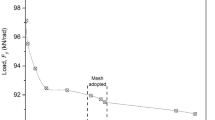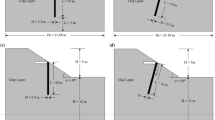Abstract
The ground improvement technique of stone columns has been effectively used over the last decades in order to accelerate the consolidation rate of soft soils by providing a drainage path, reduce foundation settlements, improve the bearing capacity of the soil, and limit the risk of liquefaction due to seismic activity. Because of the time consumption of a three dimensional (3D) calculation, most stone column projects are presently studied by axisymmetric finite element computations. Otherwise, it is the analytical method of Priebe that is commonly used to predict the final settlements of a single stone column and the corresponding settlement reduction factor. Both methods, axisymmetric finite element analysis and Priebe’s analytical method make use of the axisymmetric theory of unit cell. The main objective of this study is to examine and compare the three dimensional response of stone column reinforced soils with the axisymmetric analysis results. A proposed analytical method, governed by the failure mechanism of a cylindrical cone is also presented. The comparison between these different approaches is studied and evaluated in conjunction with in situ measurements. It is proved that the beneficial effect of this ground improvement technique, especially on the foundation soil with the lower strength characteristics, is more pronounced. Also, it is concluded that due to unit cell theory, the settlement reduction factor is usually under predicted and the failure of the composite system is impossible, even under high applied pressures. The proposed analytical method of the cylindrical cone failure mechanism is proved to be in good agreement with the 3D results.








Similar content being viewed by others
Abbreviations
- A:
-
Unit cell area
- Ac :
-
Single stone column area
- B:
-
Foundation width
- cu :
-
Undrained shear strength of the soil
- dc :
-
Stone column diameter
- E:
-
Elastic modulus
- Ec :
-
Elastic modulus of the column
- Es :
-
Elastic modulus of the soil
- H:
-
Column length
- hcritical1 :
-
Depth of maximum stone column bulge
- hcritical2 :
-
Depth where the granular material reaches the elastic zone
- kαc :
-
Active column pressure coefficient
- kos :
-
Lateral earth soil pressure coefficient at rest
- kpc :
-
Passive column pressure coefficient
- n:
-
Stress concentration ratio
- q:
-
Applied pressure
- R = Rc + ΔRc :
-
The increased radius of the column Rc by ΔRc
- s:
-
Stone column center-to-center spacing
- sc,elastic :
-
Stone column settlements in elastic zone
- sc,plastic :
-
Stone column settlements in plastic zone
- sf :
-
Settlements after improvement
- so :
-
Settlements before improvement
- uo :
-
Initial pore pressure
- αs :
-
Area replacement factor
- β:
-
Settlement reduction factor
- γ:
-
Unit weight
- γ′s :
-
Effective soil unit weight
- γw :
-
Water unit weight
- v:
-
Poisson’s ratio
- vs :
-
Soil Poisson’s ratio
- σ′h,s :
-
Radial effective soil stress after consolidation process
- σ′h,smax :
-
Limiting radial effective stress of soil
- σ′h,so :
-
Initial radial effective soil stress
- σc :
-
Distributed stone column vertical stress
- σ′h,c :
-
Horizontal effective column stress
- σ′v,c :
-
Vertical effective column stress
- φ:
-
Friction angle
- φc :
-
Friction angle of the gravel
- φ′s :
-
Friction angle of the soil
References
ABAQUS Inc. (2004) ABAQUS V.6.4. User’s manual. Providence, Rhode Island, USA
Andreou P (2009) Simulation of stone column reinforced soils. Ph.D thesis, School of civil engineering, NTUA, Athens, Greece, pp 265
Andreou P, Papadopoulos V, Zervogiannis H (2006) Finite element modeling of stone columns/a case study. In: International symposium on ultimate limit states of geotechnical structures (ELU–ULS), Paris, 53–58
Andreou P, Frikha W, Frank R, Canou J, Papadopoulos V, Dupla JC (2008) Experimental study on sand and gravel columns in clay. Ground Improv 161(GI4):189–198
Bachus RC, Barksdale RD (1984) Vertical and lateral behavior of model stone columns. Proc Actes du Colloque Int: Renf en place des sols et des roches, Paris 1:99–104
Barksdale RD, Bachus RC (1983a) Design and construction of stone columns. Vol I, Report No. FHWA/RD–83/026, pp 210
Barksdale RD, Bachus RC (1983b) Design and construction of stone columns, Vol II–Appendixes, Report No. FHWA/RD–83/026, pp 45
Bergado DT, Chai JC, Alfaro MC, Balasubramaniam AS (1994) Improvement techniques of soft ground subsiding and lowland environment. Balkema Publishers, Rotterdam, p 222
Charles JA, Watts KS (1983) Compressibility of soft clay reinforced with granular columns. In: Procedings of the 8th European Conference on Soil Mechanics and Foundation Engineering, Helsinki, 1, 347–352
Guermazi A (1986) Analyse théorique et expérimentale du comportement d’un sol renforcé par colonnes ballastées. Thèse de Doctorat, Paris VI, E.N.P.C., Paris, France
Hughes JMO, Withers NJ (1974) Reinforcing of soft cohesive soils with stone columns. Ground Eng 7(3):42–49
Hughes JMO, Withers NJ, Greenwood DA (1976) A field trial of the reinforcing effect of a stone column in soil Ground treatment by deep compaction. The institution of Civil Engineers, London (p.p. 154), pp 31–44
Jaky J (1944) The coefficient of earth pressure at rest. Journal of the Society of Hungarian Architects and Engineers, Budapest, pp 355–358
Mihalis IK, Papadopoulos BP, Anagnostopoulos AG (2003) The contribution of stone columns to the improvement of the stability conditions of embankments on soft clays. In: Proceedings of the XIIIth European Conference on soil Mechanics and Geotechnical Engineering, Prague, 25–28th August, Vol 1, pp 827–832
Mitchell JK, Huber TR (1985) Performance of a stone column foundation. J Geotech Eng 111(2):205–223
Normes Francaises NFP 11-212 (2005) Recommandations sur la conception, le calcul, l’exécution et le contrôle des colonnes ballastées sous bâtiments et ouvrages sensibles au tassement. Revue Française de Géotechnique, 2ème trim, 111, 3–16
Poorooshasb HB, Meyerhof GG (1997) Analysis of behavior of stone columns and lime columns. Comput Geotech 20(1):47–70
Poulos HG, Davis EH (1974) Elastic solutions for soil and rock mechanics. Wiley, New York
Priebe HJ (1995) The design of vibro—replacement. Ground Eng, Keller Grundbau GmbH, Technical paper 12–61E, pp 16
Schweiger HF, Pande GN (1986) Numerical analysis of stone column supported foundations. Comput Geotech 2:347–372
Soyez B (1985) Méthodes de dimensionnement des colonnes ballastées. Bull de Liaison des Laboratoires des Ponts et Chaussées, Paris 135:35–51
Vesic AS (1972) Expansion of cavities in infinite soil mass. J Soil Mech Found Div A.S.C.E. 98(SM3):265–290
Watt AJ, De Boer BB, Greenwood DA (1967) Loading tests on structures founded on soft cohesive soils strengthened by compacted granular columns. In: Proceedings of the 3rd Asian Regional Conference on Soil Mechanics and Foundations Engineering, pp 248–251
Plaxis bv (2012) Plaxis V8 user's manual. The Netherlands
Author information
Authors and Affiliations
Corresponding author
Rights and permissions
About this article
Cite this article
Andreou, P., Papadopoulos, V. Factors Affecting the Settlement Estimation of Stone Column Reinforced Soils. Geotech Geol Eng 32, 1175–1185 (2014). https://doi.org/10.1007/s10706-014-9788-x
Received:
Accepted:
Published:
Issue Date:
DOI: https://doi.org/10.1007/s10706-014-9788-x




